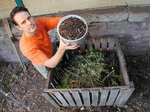

Welcome to a new gardening season! Spring seems to have finally arrived and if you’re like me, you’re making big plans for this year’s outdoor projects. This would be a great time to consider starting or expanding your home composting efforts. Composting is a great way to reduce waste while improving soil health, and your setup can be as simple or elaborate as you like. Whether you’re a seasoned composter or have never done it before, read on for some helpful tips.
First, you may be wondering – why bother with home composting when you could just participate in the city’s curbside composting program? Personally, I do both. As I’ll discuss further below, there are some things that can’t be added to a home compost pile, and I’ll put many of those in my city compost bin. But I like being able to compost the majority of my food waste at home, reducing the resources needed to recycle it. Plus, it’s convenient to have fresh compost readily available without having to arrange pickup or delivery!
So, how does composting work? Essentially, you are creating the ideal conditions for naturally occurring microbes to convert organic waste into a useful soil amendment. When done correctly, you won’t have bad smells or attract pests. And the resulting product (i.e. the finished compost) contains nutrients that benefit your plants and soil.
There are lots of options for how to physically create your compost pile. It could be as simple as a pile of organic waste in the corner of your yard (although I would recommend having some sort of structure to keep things contained). Ideally, your compostable materials will be held in a roughly cylindrical shape, approximately three to five feet across. This is a good size to allow the compost to generate heat for decomposition, while also letting air and water penetrate the pile. You could create a cylinder of chicken wire or snow fencing, or stack cement blocks or bricks with some spaces in between for airflow. There are also many types of compost bins available to buy – everything from a simple plastic bin to a rotating cylinder on raised legs. You can determine what will work best for your space and aesthetic preferences.
Many types of kitchen and yard waste can be composted at home, but not everything! For kitchen waste, you can compost things like coffee grounds, eggshells, fruit and vegetable scraps, and shredded newspaper. Compostable yard waste includes grass clippings, fall leaves, straw, and small twigs. You should not compost meat, bones, grease, whole eggs, dairy products, pet feces, and diseased plants. These things can spread disease or attract pests. Personally, I also avoid composting most weeds because the pile may not heat up hot enough to kill weed seeds and I don’t want to spread them around my yard. And keep in mind that the smaller you cut things up before composting, the faster they will decompose.
To create the best conditions for decomposition, you should aim to maintain a balance of “greens” (nitrogen-rich materials like grass clippings and vegetable and fruit scraps) and “browns” (carbon-rich materials like fall leaves, newspaper, and straw). The exact ratio is not important, but overall, aim to have more browns than greens in your compost pile. If your compost pile smells bad, you probably need to add some browns. If it doesn’t seem to be decomposing, add some greens. Also, aim to mix your compost once or twice a month and add some water if it seems very dry. Once you stop adding new material to a compost pile, it will generally be ready to use within a few months. Compost is finished when it’s reduced to about half of its original volume and has an earthy smell, with no recognizable food pieces still visible.
In the winter, you can still add things to your compost pile, but they will likely not decompose much when temperatures are low. Personally, I put most of my food waste out for city compost pickup over the winter and resume adding to my own pile in the spring. You can also try indoor composting using worms – also referred to as “vermicomposting.” Although vermicomposting may seem intimidating, it is pretty simple and can be a lot of fun!
For more information, check out the University of Minnesota Extension Yard and Garden website. Extension resources are written by experts and contain the latest and most reliable research-based information. Happy gardening!
Comments
No comments on this item Please log in to comment by clicking here